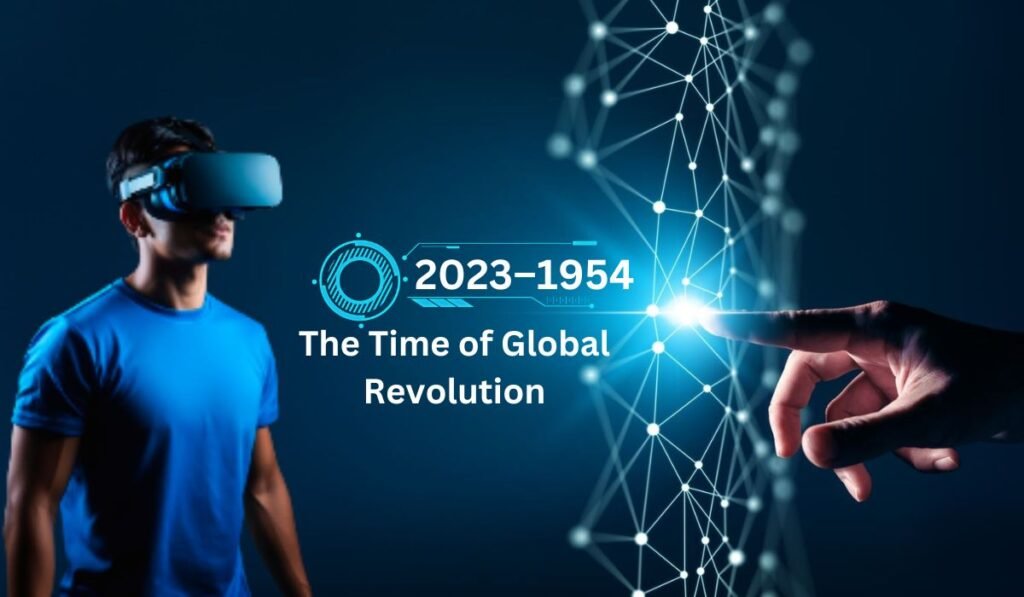The period from 2023-1954 marks an era of dramatic transformation in global history. This timeframe witnessed significant shifts in political power, technological advancements, social movements, and environmental awareness, reshaping the world into its current form. From the height of the Cold War to the digital age and beyond, this era has been defined by rapid changes that continue to shape the trajectory of human civilization. Understanding these developments provides a window into how the world evolved over the past seven decades.
Table of Contents
The Cold War Era (1954–1991)
The Cold War dominated global politics from the mid-1950s to the early 1990s. The United States and the Soviet Union emerged as superpowers after World War II, engaging in a prolonged ideological and geopolitical struggle. This period was characterized by military build-ups, nuclear arms races, and proxy wars across the globe, such as the Vietnam War and the Korean War. The Cuban Missile Crisis of 1962 brought the world to the brink of nuclear conflict, highlighting the high stakes of this rivalry. At the same time, the Space Race symbolized the competition for technological and ideological supremacy.
Post-Cold War Changes (1991–2001)
The collapse of the Soviet Union in 1991 marked the end of the Cold War and the beginning of a new global order. The United States emerged as the sole superpower, ushering in an era of unipolarity. During this time, globalization accelerated as countries increasingly integrated economically through trade and technological advancements. The 1990s also saw significant advances in technology, such as the widespread adoption of the internet, which began to reshape industries and communication.
The Digital Revolution (1990s–2000s)
The digital revolution, starting in the 1990s, fundamentally transformed the way people live, work, and communicate. The rise of personal computers and the internet opened new avenues for information sharing and global connectivity. By the 2000s, mobile technology and social media platforms like Facebook, Twitter, and YouTube redefined how people interacted with each other, making the world more interconnected than ever before. This period laid the foundation for the current digital economy and the information age.
Economic Transformations (1954-2023)
The global economy underwent substantial changes during this period, shaped by shifts in trade, industrialization, and financial crises. The post-World War II boom was followed by the oil shocks of the 1970s, which led to economic recessions in many parts of the world. However, the liberalization of economies in the 1980s and 1990s, particularly in China and India, transformed them into economic powerhouses. More recently, the 2008 financial crisis and the COVID-19 pandemic have highlighted vulnerabilities in the global economic system, prompting discussions on the need for resilience and reform.
Cultural Shifts and Movements
The period from 1954 onwards saw significant cultural and social movements that reshaped societal norms. The civil rights movement in the United States, along with the fight against apartheid in South Africa, highlighted the struggle for racial equality. The sexual revolution and feminist movements challenged traditional gender roles, pushing for greater rights and freedoms. Additionally, pop culture evolved dramatically, with music, cinema, and television becoming major avenues for global cultural exchange, from the British Invasion of the 1960s to the rise of hip-hop and K-pop.
Science and Technological Breakthroughs
Humanity made extraordinary leaps in science and technology, from space exploration to medical advances. The 1969 moon landing by Apollo 11 marked a pinnacle of human achievement. In the 21st century, space agencies like NASA and private companies like SpaceX turned their attention to Mars and beyond. Advances in medicine have led to better treatments for chronic diseases, and the fight against pandemics like COVID-19 has accelerated developments in biotechnology and vaccine research. Meanwhile, AI and robotics have begun to reshape industries and labor markets, ushering in a new era of automation.
Environmental Awareness and Challenges
Environmental issues emerged as a global concern in the 1960s, with growing awareness about pollution and the impact of human activities on the planet. The 1970s saw the first Earth Day and the establishment of environmental protection agencies in various countries. As the effects of climate change became more evident, international agreements like the Kyoto Protocol and the Paris Agreement aimed to curb carbon emissions. The shift towards renewable energy, from solar power to electric vehicles, reflects the urgent need for sustainable solutions in the face of a warming planet.
Global Conflicts and Terrorism
While the Cold War ended, global conflicts did not cease. The Middle East became a focal point of instability, with wars in Iraq, Afghanistan, and the rise of extremist groups like ISIS. The September 11, 2001, attacks in the United States marked a turning point, leading to a global war on terror that reshaped international relations and security policies. These events highlighted the complex and evolving nature of global threats in the 21st century.
Globalization and Cultural Integration
Globalization accelerated the exchange of goods, ideas, and cultures across borders. International organizations like the United Nations, the European Union, and the World Trade Organization played a key role in fostering cooperation and economic integration. The spread of media and digital communication facilitated a cultural blending, leading to a more interconnected global society. However, globalization has also brought challenges, including cultural homogenization and economic inequality.
The Rise of Asia
One of the most significant shifts in the global balance of power has been the rise of Asia. Japan’s economic boom in the 1970s and 1980s was followed by the emergence of China as a global economic leader. South Korea’s technological advancements and India’s growth in the IT sector further contributed to Asia’s rising influence. These developments have shifted the center of economic gravity towards the East, creating a more multipolar world.
Demographic Changes and Urbanization
The global population has grown significantly since 1954, with dramatic shifts in demographics. Urbanization has led to the rise of megacities, particularly in Asia, Africa, and Latin America. At the same time, aging populations in developed countries and youth bulges in developing regions have created diverse challenges, from social security pressures to unemployment.
Pandemics and Public Health Evolution
Public health crises like HIV/AIDS, Ebola, and COVID-19 have had profound impacts on society and healthcare systems. The global response to these diseases has highlighted the need for international cooperation in health management. COVID-19, in particular, reshaped how the world approaches pandemic preparedness, leading to rapid advances in vaccine technology and new healthcare protocols.
The Rise of Social Movements and Political Polarization
The 21st century has seen the resurgence of social movements and political polarization. Movements like Black Lives Matter and MeToo have brought issues of racial and gender inequality to the forefront. Simultaneously, the rise of populism and nationalism in various countries has challenged the stability of liberal democracies, leading to deeper political divides.
Looking Ahead: Challenges and Opportunities for the Future
As the world moves beyond 2023, it faces both challenges and opportunities. Addressing climate change remains a pressing concern, requiring global cooperation and innovation. Technological advances like AI, space exploration, and renewable energy hold the promise of shaping a better future. Navigating geopolitical tensions and fostering global cooperation will be key to ensuring a peaceful and prosperous world in the decades to come.
Conclusion
The period between 2023-1954 has been marked by immense change, shaping the modern world in profound ways. From the tensions of the Cold War to the rise of digital technology, from the growth of global economies to the pressing challenges of climate change, these decades have seen humanity at its best and its most challenged. Understanding this period of transformation helps us appreciate the complexities of today’s world and the path forward.
FAQs
What were the major events of the Cold War era?
Key events include the Vietnam War, Cuban Missile Crisis, and the Space Race between the US and USSR, shaping global politics during this period.
How did the digital revolution change the world?
The digital revolution introduced the internet, transformed communication, and led to the rise of new industries, fundamentally altering everyday life.
What impact did globalization have on economies?
Globalization facilitated economic growth, increased trade, and cultural exchange, but also brought challenges like economic inequality and cultural homogenization.
Why is the period 1954-2023 considered transformative?
This period saw rapid advancements in technology, significant political shifts, and social changes, making it one of the most dynamic eras in history.
What challenges does the world face after 2023?
Key challenges include climate change, geopolitical tensions, and adapting to technological advancements like AI and automation.
Also Read More:
Exploring Tech.desacanggu.id: A Comprehensive Guide to a Tech Hub in Nigeria


